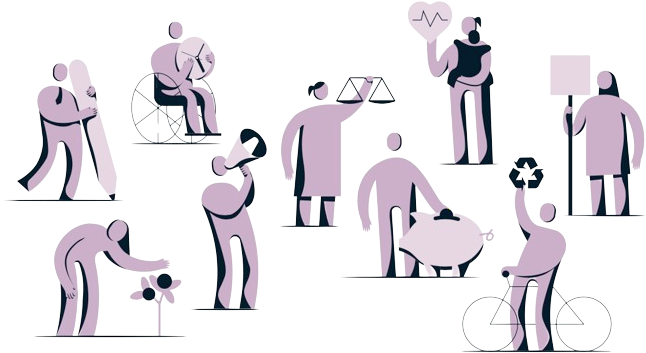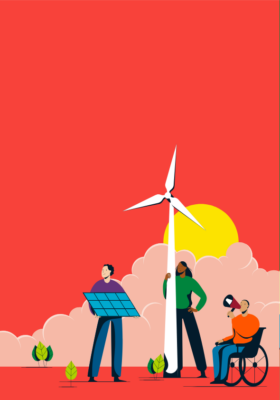“What can we do now in order to be able to do tomorrow what we are unable to do today?“
― Paulo Freire, Pedagogy of Hope: Reliving Pedagogy of the Oppressed
You have done your research and have a sketch of your analysis (the community, its needs) and your vision of a doable renewable energy project. Strategy is the bridge that carries you from your analysis to your vision.
Strategy is knowing how to turn the resources you have (people, tools, skills, time) into the power you need to achieve the change you want.
Your strategy will guide you when deciding how to organise actions, how to prioritise your work, and how to allocate your resources. How can we make sure each action moves you closer to your destination? Which path will get you there faster, and more securely?
Your strategy isn’t set in stone: it’s important to remain flexible and reassess regularly. If a new path for action appears that you hadn’t foreseen, your strategy can help you decide whether to take the new shortcut or not.
Your strategy will help you avoid spreading energy among many different actions that don’t achieve concrete gains: a good strategy will make your group focus on its goal.
Build a project proposal
Renewable energy projects need an array of resources. You can use the list below to help you design your plan: what needs to happen before and what needs to happen after, who will be responsible for each thing, when it will be done and what resources are needed for it to happen.
( ) Ensure the project aligns with the community’s needs and values, building strong support and avoiding potential oppositions. Gaining acceptance and support from the local community is essential for a smooth project development process and addressing its concerns can foster positive relationships. Keep the conversation going with the community throughout the planning, implementation and operation phase of the project.
( ) Build a detailed technical plan for the project, including a viability assessment to determine the most suitable renewable energy technology for your community (solar, wind). Experts will support you in the definition of the layout, equipment specifications and system integration with the existing power grid or the development of a microgrid to ensure that protocols are being followed and also to give proper support during the life cycle of the project and later on for maintenance purposes.
( ) Finding a proper site location (preferably an abandoned/low-use land). You want a location with effective sun exposure or wind speed or adequate water flow for a micro hydro project. Solar projects need access to areas with ample sunlight, and wind projects require areas with consistent wind speeds. An equally important aspect is to design a project that minimises negative impacts on the environment and increases the community benefits. For that reason, we encourage looking for low-use land such as abandoned fields, car parks, and capped landfills.
( ) Act in accordance with local regulations to know what permits and approvals will be needed. Obtaining necessary permits is critical for establishing your project. This involves navigating through various environmental, legal, and community considerations. Government policies and regulations can play a significant role in promoting or impeding RE projects to happen.
( ) Identify local partnerships that can provide political, technical and financial support to your project (local governments, environmental and climate organisations, energy utilities, potential investors and renewable energy service providers).
( ) Secure reliable access to renewable energy equipment and materials is crucial for project implementation. This includes solar panels, wind turbines, geothermal systems, biomass generators, etc.
( ) Secure financing to cover the project implementation costs and maintenance (grants, loans, crowdfunding, public investment). Sufficient funding is essential for the development, construction, and maintenance of your project. This includes capital for equipment, installation, operation, and ongoing maintenance.
( ) Identifying potential risks and developing mitigation strategies is crucial to ensure the long-term success and viability of the project. Establishing systems to monitor the project’s performance and evaluate its impact over time allows for ongoing improvements and adjustments.
Your core team does not have to know or have done all these things! But this can be the basic structure of your project and writing these down will be the basis of pitches/funding proposals. For each of these topics, a list of actions needs to be taken. And for this, it is important to put them in a proposal sequencing the actions that need to be done, who will do it and when.
Each renewable energy project is unique (“one size does not fit all”), and the specific requirements may vary based on the type of technology, scale, location, and local context. Properly addressing these ingredients can help ensure the success of your RE project.

Create a basic campaign timeline
In order to make your community-led renewable energy project viable, you will eventually need political support, the financial and logistical hurdles figured out, and the support of the community. A campaign is a series of events to help build power, create a feeling of consensus (and isolate detractors), and keep momentum for your project to succeed.
Your campaign is like a pathway drawn on a map – an idea of how to get from where you are now, to a future where your target agrees to – and implements – your demand. The timeframe for your journey should be both realistic and dynamic: you won’t get there overnight, but your campaign won’t last for decades.
To achieve your project goals you’ll want to pick a range of actions that might help you achieve those ends (we call them “tactics”). You want to start with the size you are — if you’re small, do small and get bigger (don’t pretend to have all the community support behind you if you don’t). You order a range of different tactics in a way that creates momentum, allows your group to grow, and is within the capacity of your team to organise.
Some tactics include:
- Community Meetings: Organise public meetings or town halls to introduce the campaign, share information about renewable energy, and engage with community members. Provide opportunities for questions, discussions, and feedback.
- Door-Knocking and Leafleting: Mobilise volunteers to go door-to-door in the community, distributing campaign literature, and engaging in conversations about the benefits of renewable energy. This personal approach allows for direct interaction and the opportunity to address individual concerns.
- Online Presence: Establish a strong online presence through a dedicated campaign website, social media platforms, and email newsletters. Utilise these channels to share campaign updates, educational content, success stories, and opportunities for involvement. Encourage supporters to share the campaign’s online presence with their networks.
- Create factsheets on how the current system does not work and how the solution benefits the community. Give examples of how the community has previously made changes. Include frequently asked questions to address common opposition points. Share these fact sheets at community events, townhalls, etc.
- Partnerships and Alliances: Collaborate with local organisations, environmental groups, schools, and businesses that share similar goals or have an interest in renewable energy. Leverage their networks and support to amplify your campaign’s reach and credibility.
- Media Engagement: Draft press releases, reach out to local newspapers, radio stations, and TV channels to raise awareness about your campaign. Offer to provide interviews, write op-eds, or host media events to generate media coverage and increase visibility.
- Educational Workshops: Conduct workshops or informational sessions to educate the community about renewable energy technologies, their benefits, and how individuals can implement them at home. Empower community members with the knowledge and tools to take action.
- Local Events and Festivals: Set up information booths or host workshops at local events, farmers’ markets, or community festivals. Engage with attendees, distribute materials, and create interactive displays to spark interest and initiate conversations about renewable energy.
- Collaborative Art and Awareness Projects: Consider using art installations, community murals, or creative awareness projects to draw attention to the campaign. Art has the power to inspire and engage people in meaningful conversations.
- Engage Local Leaders: Reach out to local government officials, community leaders, and influential figures to gain their support and endorsement for the campaign. Their involvement can lend credibility and help navigate potential hurdles.
- Volunteer Recruitment: Actively recruit and engage volunteers who are passionate about renewable energy and community activism. Provide them with clear roles and responsibilities to ensure smooth campaign operations.
Then order those tactics in a way that:
- Shows growing support;
- Keeps persuading the people you will need over time (e.g. Mayor, City Council);
- Identifies the challenges and calmly explains how they will be overcome (“where will we find the money?” or “where do we find the land?”)
- Reaches out to groups that might be likely to oppose the campaign early on (What opposition might surprise you — and how to counter it)
Before you start planning your tactics, it is good to write down your shared vision and goals. They will help you think about coordinated tactics so that you can achieve your goals.
If your team comes from climate campaigning where you were often stopping pipelines, you’ll note that campaigning for is very, very different than campaigning against.

Tips for climate campaigners who are campaigning for.
A lot of climate campaigners have worked on stopping bad projects. You poke holes in the project. You slow it down. You use different talking points to turn people against a project.
This is different: you have a project you want to support. You are building a positive Campaign.
So let’s acknowledge some tendencies from climate campaigners that are not effective.
#1: It’s not just climate, be flexible in why people love the project
We run campaigns because of our values. But when campaigns are most effective they link with widely-shared values.
One Brazilian campaigner describes it this way:
We were discussing getting solar on our apartment. I care deeply about the climate and kept making the climate argument. But even while some people said they cared, that argument did not win the day. What won the argument was the economic one: “Will I have to pay more?” They needed to see the economic argument: the building will increase in value, our energy bill will be reduced… We won our campaign when we spoke to people’s needs.
We encourage people to remember Why Community-led?.
#2: Don’t escalate to protests too fast
A second tendency for climate campaigners is getting combative too quickly. People can be so impatient that we don’t appreciate that winning these campaigns can take years of hard work – and despite the urgency of the issue, we still have to win over a bureaucracy. You can’t win a bureaucracy if you only dismiss it and attack it. You’ll have to also be persuasive.
Climate campaigners sometimes start attacking people who aren’t doing what they want (or are only half-doing it). But when you escalate, you may end up only undermining your internal advocates and further isolating them from their more mainstream colleagues (Their colleagues say: “See? They won’t even support you! I told you they’re unreasonable.”) Don’t undermine your allies — even if they aren’t all you want from them — in public.
Start slow. Our experience is that the best campaigners set up reasonable timetables and don’t use escalated actions until much later.
At the same time, it’s good to keep alerting people that you can do direct action. Creative groups have signalled their direct action prowess by:
- Publicly doing direct action with other groups to keep their skills up (and a show of force about of what they can do);
- Doing high-profile nonviolent direct action trainings
Read more about tips about working with bureaucracy: How your solutions campaign deals with bureaucracy
#3: Don’t rely on your traditional allies
In many cities you may have your “climate-minded” politicians. These are not necessarily the people you want to be aligned with. Take this strategy from one US campaign:
We want to get a resolution introduced. So we called up our two Progressive Councilmembers and urged them to not introduce the resolution. They were a little surprised, but we told them we wanted time to build community power — and we were worried that if they introduced it, it would be as marginalised as most of their bills. We organised for 6 months until other Councilmembers contacted us about introducing a bill. At that point, we looped in our Progressive Councilmembers and, buoyed by the Centrist councilmembers, the bill passed unanimously.
In other words, keep your traditional allies close — but keep broadening your political support base.
Public launch
Your community needs to know about your campaign. Up until now you have had a small core team meeting with many stakeholders, experts, and maybe even some key political supporters. You’ve figured out your campaign ask — the demand and a basic chart on how you’ll get it.
Now you tell the world. You make it public for everyone.
Here’s an important reminder: Once you “launch” there will remain many community members who don’t know about the campaign. But it’s still a good idea to have a “launch” moment — for your psychology and for the community.
This may take different forms: it may include a website where people can sign up for the campaign, a public press conference where you invite press to talk about the coalition’s aims, a delivery of a petition from the community showing support for this project.
Since it’s a community-driven project, you might want to turn towards more community-minded events:
- Invite the neighbourhood to a “pre-dig” ceremony on the piece of land
- Host a party!
- Host a contest/giveaway
- Involve a local school — connect it to the annual science fair or climate event in the area
This is typically the time to initially bring in Media. Don’t be discouraged if the press don’t jump on this right away — they are busy and may want to see if this a “realistic” project before covering. You have time to convince them.
This is also a good moment to bring in political allies — local mayors and others to talk about why they’re excited to support this project.
The goal is to make a splash — to make it possible for supporters to show their support and to create a positive atmosphere around this project.
At the event, make sure to get people’s contact information for follow-up later.
Supplemental Resources
| Articles / Resources | Tactics to keep up the momentum How your solutions campaign deals with bureaucracy How to create actions that will get media How to create a campaign plan: the paper plate challenge (the simplest way for a small group to create a basic campaign timeline) Recruiting outside your social circle |
| Trainings | TRAINING: Build your strategy TRAINING: Create your campaign timeline Online Course: Introduction to Campaigning People-Sized Strategy Board Game: Renewable Energy (RE) Edition |








